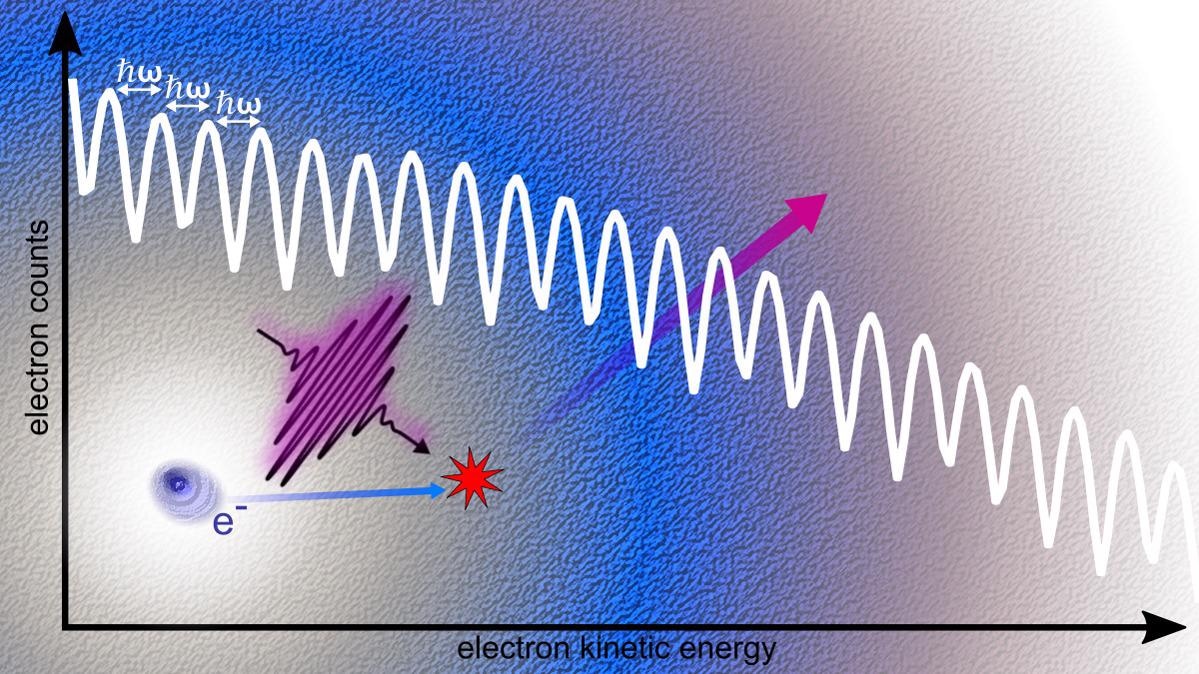For the first-ever time, researchers have demonstrated the absorption of energy from laser light by free electrons in a liquid. So far, this process was noted only in the gas phase. The results of the study, headed by the Graz University of Technology, pave a new way for ultrafast electron microscopy.
 Schematic representation of a LAES process in superfluid helium: The electron collides with the material sample (red star), thereby absorbing energy from the light field and changing its direction. Image Credit: © IEP – TU Graz.
Schematic representation of a LAES process in superfluid helium: The electron collides with the material sample (red star), thereby absorbing energy from the light field and changing its direction. Image Credit: © IEP – TU Graz.
The analysis and development of materials mainly rely on the potential to view the smallest objects at the quickest time scales. The spatial resolution required for investigations in the (sub-) atomic range can be realized with electron microscopy. However, in the case of very fast processes that proceed in a few femtoseconds (quadrillionths of a second), the time resolution of traditional electron microscopes is inadequate.
To achieve an improvement in the time duration of electron pulses, electrons would have to be chosen inside a shorter time window — similar to a camera shutter, which regulates the exposure time in photography.
Theoretically, such a temporal selection is viable with extremely short laser pulses using a process known as laser-assisted electron scattering (LAES). In this method, electrons have the ability to absorb energy from the light field at the time of collisions with atoms of the sample under examination.
Structural information is provided by all electrons, but those that have a higher energy level can be assigned to the time window in which the light pulse was present. With this method, it is possible to select a short time window from the long electron pulse and thus improve the time resolution.
Markus Koch, Professor, Institute of Experimental Physics, Graz University of Technology
But up until now, LAES processes have only been noted in the gas phase, although investigations have been carried out for nearly five decades.
Markus Koch and his group joined hands with scientists from the Photonics Institute at Vienna University of Technology and the Institute of Chemistry at Tokyo Metropolitan University and have shown, for the first-ever time, that laser-assisted electron scattering can also be seen in condensed matter, particularly in superfluid helium.
Superfluid Helium Leading to Success
Scientists from TU Graz have executed the experiment in a superfluid helium droplet with a diameter of few nanometers (ranging from 3 to 30 nm), into which single atoms (indium or xenon) or molecules (acetone) that act as an electron source were loaded — an area of expertise at the institute.
The free electrons can move almost without friction within the droplet and absorb more energy in the light field than they lose in collisions with the helium atoms.
Leonhard Treiber, PhD Student, Institute of Experimental Physics, Graz University of Technology
Treiber was in charge of the experiment. The consequent acceleration enables the observation of much quicker electrons.
The experiments could be understood in collaboration with Markus Kitzler-Zeiler, an expert for strong-field processes at TU Wien, and the LAES process was verified via simulations by Reika Kanya from Tokyo Metropolitan University. The study findings were published in the journal Nature Communications.
Later, the LAES process will be investigated inside thin films made of different materials, which are also produced within helium droplets, to identify essential parameters like the optimal film thickness or the favorable intensity of the laser pulses for use in an electron microscope.
This study was financially supported by an Austrian Science Fund project and is fixed in the Field of Expertise “Advanced Materials Science,” one of five strategic focus regions of TU Graz. Participating scientists are the members belonging to the NAWI Graz Physics.
Journal Reference:
Treiber, L., et al. (2021) Observation of laser-assisted electron scattering in superfluid helium. Nature Communications. doi.org/10.1038/s41467-021-24479-w.